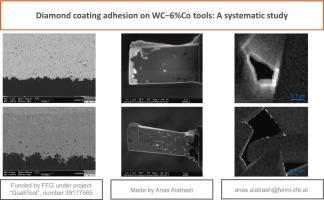Diamond coating adhesion on WC − 6 %Co tools: A systematic study
IF 4.6
2区 材料科学
Q2 MATERIALS SCIENCE, MULTIDISCIPLINARY
International Journal of Refractory Metals & Hard Materials
Pub Date : 2025-09-29
DOI:10.1016/j.ijrmhm.2025.107465
引用次数: 0
Abstract
Achieving a consistent and well-adhering diamond coating remains a challenge for WC-Co tools. We analyze the microstructure of tungsten carbide and cobalt using electron microscopy and diffraction techniques. We examine batches with good and poor layer adhesion at three stages: uncoated, after pretreatment, and after coating. The samples are differentiated based on their magnetic saturation value. This study focuses on WC-6 %Co with a mean WC grain size of 1.2 μm and vanadium doping.
The results reveal a direct correlation between magnetic saturation and diamond coating adhesion to the substrate surface. Magnetic values represent the tungsten content and, consequently, the corrosion resistance of the binder phase (cobalt). An ignoble binder (low corrosion resistance) is prone to excessive etching and improper diamond nucleation. Batches with a noble binder show consistent coating formation, consistent diameter reduction, and consistent depletion zone depth. In contrast, batches with an ignoble binder exhibit significant changes in these areas.

WC - 6% Co刀具上金刚石涂层附着力的系统研究
对于WC-Co工具来说,获得一致且粘附良好的金刚石涂层仍然是一个挑战。我们用电子显微镜和衍射技术分析了碳化钨和钴的微观结构。我们在三个阶段检查具有良好和较差层附着力的批次:未涂覆,预处理后和涂覆后。根据磁饱和值对样品进行分类。本文主要研究WC- 6% Co, WC平均晶粒尺寸为1.2 μm,并掺杂钒。结果表明,磁饱和度与金刚石涂层在基体表面的粘附力之间存在直接关系。磁性值代表钨的含量,因此代表粘合剂相(钴)的耐腐蚀性。不合格的粘结剂(低耐蚀性)容易造成过度蚀刻和金刚石成核不当。具有高贵粘合剂的批次显示一致的涂层形成,一致的直径减小和一致的耗尽区深度。相比之下,具有不合格粘合剂的批次在这些区域表现出显着变化。
本文章由计算机程序翻译,如有差异,请以英文原文为准。
求助全文
约1分钟内获得全文
求助全文
来源期刊
CiteScore
7.00
自引率
13.90%
发文量
236
审稿时长
35 days
期刊介绍:
The International Journal of Refractory Metals and Hard Materials (IJRMHM) publishes original research articles concerned with all aspects of refractory metals and hard materials. Refractory metals are defined as metals with melting points higher than 1800 °C. These are tungsten, molybdenum, chromium, tantalum, niobium, hafnium, and rhenium, as well as many compounds and alloys based thereupon. Hard materials that are included in the scope of this journal are defined as materials with hardness values higher than 1000 kg/mm2, primarily intended for applications as manufacturing tools or wear resistant components in mechanical systems. Thus they encompass carbides, nitrides and borides of metals, and related compounds. A special focus of this journal is put on the family of hardmetals, which is also known as cemented tungsten carbide, and cermets which are based on titanium carbide and carbonitrides with or without a metal binder. Ceramics and superhard materials including diamond and cubic boron nitride may also be accepted provided the subject material is presented as hard materials as defined above.

 求助内容:
求助内容: 应助结果提醒方式:
应助结果提醒方式:


